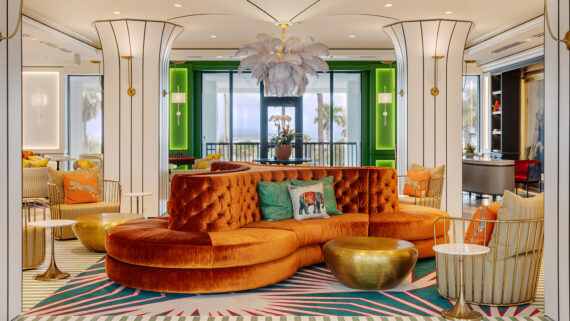
Sarasota Modern: Simple, Sleek Style
Like so many great pieces of art not appreciated in its own time, Sarasota Modern architecture’s fame and recognition came delayed – roughly 60 years tardy.
By Michael Chatfield | Photos: interior photos © Mark Borosch; exterior photos © Martie Lieberman | Interior Design for third photo by Tanya Burley Designs
Modest with their clean, open, contemporary floor plans that span just 1,500 square feet, the Sarasota Modern homes are still a striking architectural wonder sought after by design aficionados. The homes – characterized by modern geometric designs that harmonize with Sarasota’s prevailing breezes, sunlight exposures, and tropical landscapes – are scattered throughout the city and county. There are an estimated 50 remaining buildings, designed during the movement’s golden years of 1947 to 1966, that still can be seen – and many toured – today.
The movement started following World War II, when returning servicemen and their families flocked to Florida and Sarasota – sparked by their affection from their time as Air Force and Navy cadets at Sarasota’s Army Airfield. The population doubled, turning citrus groves and cattle pastures into shopping centers and housing developments.
After his own war service, Paul Rudolph moved to the region and, along with Ralph Twitchell, kick-started the Sarasota Modern style that combined ideas and concepts from contemporary architectural superstars, such as Frank Lloyd Wright and Ludwig Mies van der Rohe. The result was a group of young, smart, and ambitious architects that also included Victor Lundy, William Rupp, Jack West, and Edward J. (“Tim”) Seibert. Rudolph designed many of the movement’s most important buildings, including the Cohen House on Siesta Key and the Philip Hiss Residence (aka the Umbrella House) on Lido Key.
Certain signature touches that made these homes so unique played off the natural elements of Sarasota, like clerestory windows (windows above eye level), sliding walls of glass, and screened-in porches, which let light and the lush Florida landscape in. One of the most notable hallmarks was a floor plan that compensated for the lack of then-prohibitively expensive air-conditioning. Taking great care in orientation allowed natural cooling breezes to sweep the homes, as well as the use of jalousies windows. Still used today, jalousies consist of a row of parallel slats of glass connected to a track, allowing them to rotate open.
Sarasota Modern On Your Own
To peer inside these architectural, join the Sarasota Architectural Foundation that takes interested parties into some of the following signature Sarasota Modern homes.
The Cohen House
On Siesta Key, this 1955 built Paul Rudolph design sits on a canal and is known for its innovative natural ventilation system and large sliding glass doors.
The Cichon-Mitchell House
This 1962 Edward J. Seibert design in Sarasota boasts a minimalist design with clean lines and honest materials, plus white fir posts and beams.
The Cooney House
This 1967 Edward J. Seibert, known for its open and airy pavilion living room area and 10-foot walls of glass.
The Padgett House
This 1965 James Padgett design includes signature elements like the terrazzo floors, clerestory windows, and skylights, as well as a two-story living room with its own catwalk.
The Rupp-Seibert House
At Indian Beach, this 1960 William Rupp design (renovated by Edward J. Seibert) has screened-in porches that extend beyond the house, creating an outdoor living environment essential for the Florida coast.
Umbrella House
In Lido Key, find this 1953 Paul Rudolph design, which shows off floor-to-ceiling glass, large blank walls, and clean lines – classic hallmarks of the movement’s aesthetic.




